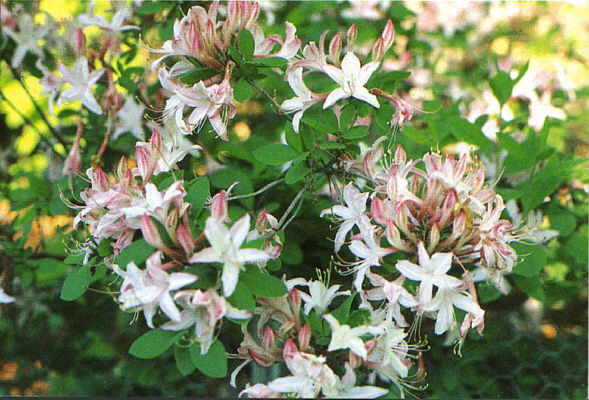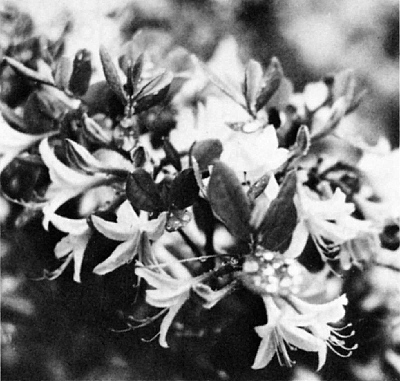QBARS - v32n4 Choptank River Hybrids
Choptank River Hybrids
Polly Hill, Vineyard Haven, Mass.
Some seedlings of the wild Rhododendron atlanticum the Coast Azalea have already been distributed as "Choptank River Hybrids", or even "Choptank River strain." This is their story and why they seem to be worthy of wider use in our gardens.
Many years ago, at least before 1957, my husband Julian W. Hill and I collected a dormant azalea plant growing wild in central Delaware, between Dover and the headwaters of the Choptank River. At the same time, and from the same general area, we transplanted several small bare rooted azaleas to our Wilmington city garden, as was our custom over the years. Dr. Donald Huttleston, taxonomist at Longwood Gardens, kindly looked over our azaleas and assigned them to their proper species.
One R. atlanticum plant flourished and was beautiful. I raised seedlings from this plant (open pollinated) and sent a flowering truss of the parent to Dr. Henry Skinner at the U.S. National Arboretum, knowing his interest in our native azaleas. He, also, identified the plant as R. atlanticum , "a very good form", as I remember. The pink color in the flower came from hybridizing long ago in the wild with R. nudiflorum , (now called R. periclymenoides ). The typical R. atlanticum is all white with a rather narrow flower, but Dr. Skinner explained that the broader flower and pink color in the truss was the result of being a good form of the wild hybrid.
Approximately 90 seedlings from our good parent were planted in Barnard's Inn Farm, our home on Martha's Vineyard, Massachusetts. Seeds from the handsomest individuals of this group were distributed, and are now available.
The plants are truly R. atlanticum , for all their past history. They have a rich fragrance, a glaucous bluish leaf, an abundantly stoloniferous habit, all of which makes them ideal for low maintenance mass group plantings. They are fragrant, graceful, native and charming unobtrusive subjects. Their period of flowering follows lilacs which, with us, is late May and early June. Under oak trees with leafy litter over their roots they grow easily to 5'; in more exposed areas perhaps only 4'. The seedlings are vigorous and even volunteer in humusy soil. It is a plant to enjoy and not to fuss over.
There is very little difference between seedlings, and as plants mature they appear at first glance to be identical. When young they may differ in size of flower and quantity of coloring, but gradually they blend together as a single clone. In the wild the plants are accustomed to hot sandy situations in sun or shade, but with a relatively high water table. However, they enjoy damp well drained soil with leafy humus. To please my nurseryman in 1967 I selected from near Pearson's corner one individual that had the most rosy flushing inside the corolla as well as outside and named it 'Marydel'.

|
|
R. 'Marydel'
Photo by Polly Hill |
The town of that name is on the border of Delaware and Maryland near which the plants are found growing wild. 'Marydel' is registered with The American Rhododendron Society and internationally and is being asexually propagated.

|
|
Choptank River hybrid
Photo by Polly Hill |
So, here is a stable hybrid group and a selected clone from the same area. I cannot too highly recommend 'Marydel' and the Choptank River Hybrids, Rhododendron atlanticum , our native Coast Azalea.
